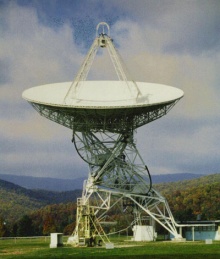“SETI 的历史 - 9”的版本间差异
(新页面: <资料来源:[http://www.planetary.org/explore/topics/seti/seti_history_09.html The Planetary Society]> =='''第9章:Opza - 一个怀疑论者的搜索'''== The lingering question...) |
小 (更新死链) |
||
| (未显示2个用户的16个中间版本) | |||
| 第1行: | 第1行: | ||
| − | <资料来源:[http://www.planetary.org/explore/topics/seti/seti_history_09.html | + | <资料来源:[https://archive.md/2008.11.15-120433/http://www.planetary.org/explore/topics/seti/seti_history_09.html Ozpa - A Skeptic's Search]> |
| − | ==''' | + | =='''第9章:Ozpa - 一个怀疑论者的搜索'''== |
| − | + | 然而,对搜索项目应该如何开展仍然存留了一些疑问,这在 Ozma 之后美国的第一个 [[SETI]] 项目上面就非常明显。以至于项目的发起人他自己,NRAO 的 G. L. Verchuur,都对这项事业的目的表露出了自己的怀疑。他在一篇描述这个项目的文章中说到:“我(作者)认为,如果我们能探测到任何其它文明的信号,很有可能只是碰巧而已,也就是说那个信号并不是特意发给我们的。因为这个原因,只去探测 21 厘米附近的波长可能并不太合适。”来自项目发起人的这番话,其中确实包含了深深的困惑。 | |
| − | [[Image:ozma_telescope.jpg|right|thumb|220px|''' | + | [[Image:ozma_telescope.jpg|right|thumb|220px|'''Ozma 项目使用的射电望远镜'''<br> |
| − | + | 位于 Gree Bank 的 85 英尺直径射电望远镜,曾被 Ozma 项目所使用,照片是新近拍摄的。图片提供:NRAO/AUI]] | |
| − | + | 不管怎样,Verschuur 还是继续了他的项目。作为 1960 年 Drake 项目的直接延续,新项目也位于西弗吉尼亚的 Green Bank。Drake 只能使用一个 85 英尺直径的射电望远镜,而 Verschuur 可使用的天线直径分别是 300 英尺和 140 英尺。在 1971 年和 1972 年间,Verschuur 将他的设备对准了九个临近的恒星,其中也包括了 Ozma 项目所研究过的一些恒星,新项目也是在氢线频率进行监听,并进行了多普勒效应修正。从某些方面来看,新项目可以看作是 Ozma 项目的扩展改进版,但从另一些方面来看,新项目的规模小得多:Drake 的团队在三个月的时间内进行了 150 小时的观测,而 Verschuur 和他的同事总共只进行了 13 个小时的观测,而且是在两年的时间内。但不管怎样,两个项目还是很相似的,以至于 Verschuur 的项目经常会被人们称之为“Ozpa”。 | |
| − | Ozpa | + | 在 Ozpa 之后还有一个更大更持久的 NRAO 搜索项目,称之为“Ozma II”,该项目在 1972 年和 1976 年之间,花费了超过 500 个小时对 674 颗恒星进行了调查。再之后的三十多年,还有一些后续搜索项目,但大部分项目的规模都比较小,往往都是利用观测站空闲的望远镜时间,用来验证一些研究人员的特定想法。然而,还是有一些规模比较大、持续时间比较长的项目,其中一些我们接下来将会说到。 |
| − | + | [[SETI 的历史|'''返回 SETI 的历史 ←''']] | [[SETI 的历史 - 8|'''第8章:新的搜索 ←''']] | [[SETI 的历史 - 10|'''→ 第10章:“哇!”''']] | |
| − | |||
| − | |||
| − | |||
| − | [[ | ||
2019年2月12日 (二) 20:34的最新版本
<资料来源:Ozpa - A Skeptic's Search>
第9章:Ozpa - 一个怀疑论者的搜索
然而,对搜索项目应该如何开展仍然存留了一些疑问,这在 Ozma 之后美国的第一个 SETI 项目上面就非常明显。以至于项目的发起人他自己,NRAO 的 G. L. Verchuur,都对这项事业的目的表露出了自己的怀疑。他在一篇描述这个项目的文章中说到:“我(作者)认为,如果我们能探测到任何其它文明的信号,很有可能只是碰巧而已,也就是说那个信号并不是特意发给我们的。因为这个原因,只去探测 21 厘米附近的波长可能并不太合适。”来自项目发起人的这番话,其中确实包含了深深的困惑。
不管怎样,Verschuur 还是继续了他的项目。作为 1960 年 Drake 项目的直接延续,新项目也位于西弗吉尼亚的 Green Bank。Drake 只能使用一个 85 英尺直径的射电望远镜,而 Verschuur 可使用的天线直径分别是 300 英尺和 140 英尺。在 1971 年和 1972 年间,Verschuur 将他的设备对准了九个临近的恒星,其中也包括了 Ozma 项目所研究过的一些恒星,新项目也是在氢线频率进行监听,并进行了多普勒效应修正。从某些方面来看,新项目可以看作是 Ozma 项目的扩展改进版,但从另一些方面来看,新项目的规模小得多:Drake 的团队在三个月的时间内进行了 150 小时的观测,而 Verschuur 和他的同事总共只进行了 13 个小时的观测,而且是在两年的时间内。但不管怎样,两个项目还是很相似的,以至于 Verschuur 的项目经常会被人们称之为“Ozpa”。
在 Ozpa 之后还有一个更大更持久的 NRAO 搜索项目,称之为“Ozma II”,该项目在 1972 年和 1976 年之间,花费了超过 500 个小时对 674 颗恒星进行了调查。再之后的三十多年,还有一些后续搜索项目,但大部分项目的规模都比较小,往往都是利用观测站空闲的望远镜时间,用来验证一些研究人员的特定想法。然而,还是有一些规模比较大、持续时间比较长的项目,其中一些我们接下来将会说到。
